Assignment on Drug Abuse | Report
VerifiedAdded on 2022/10/02
|9
|2229
|24
Assignment
AI Summary
Contribute Materials
Your contribution can guide someone’s learning journey. Share your
documents today.
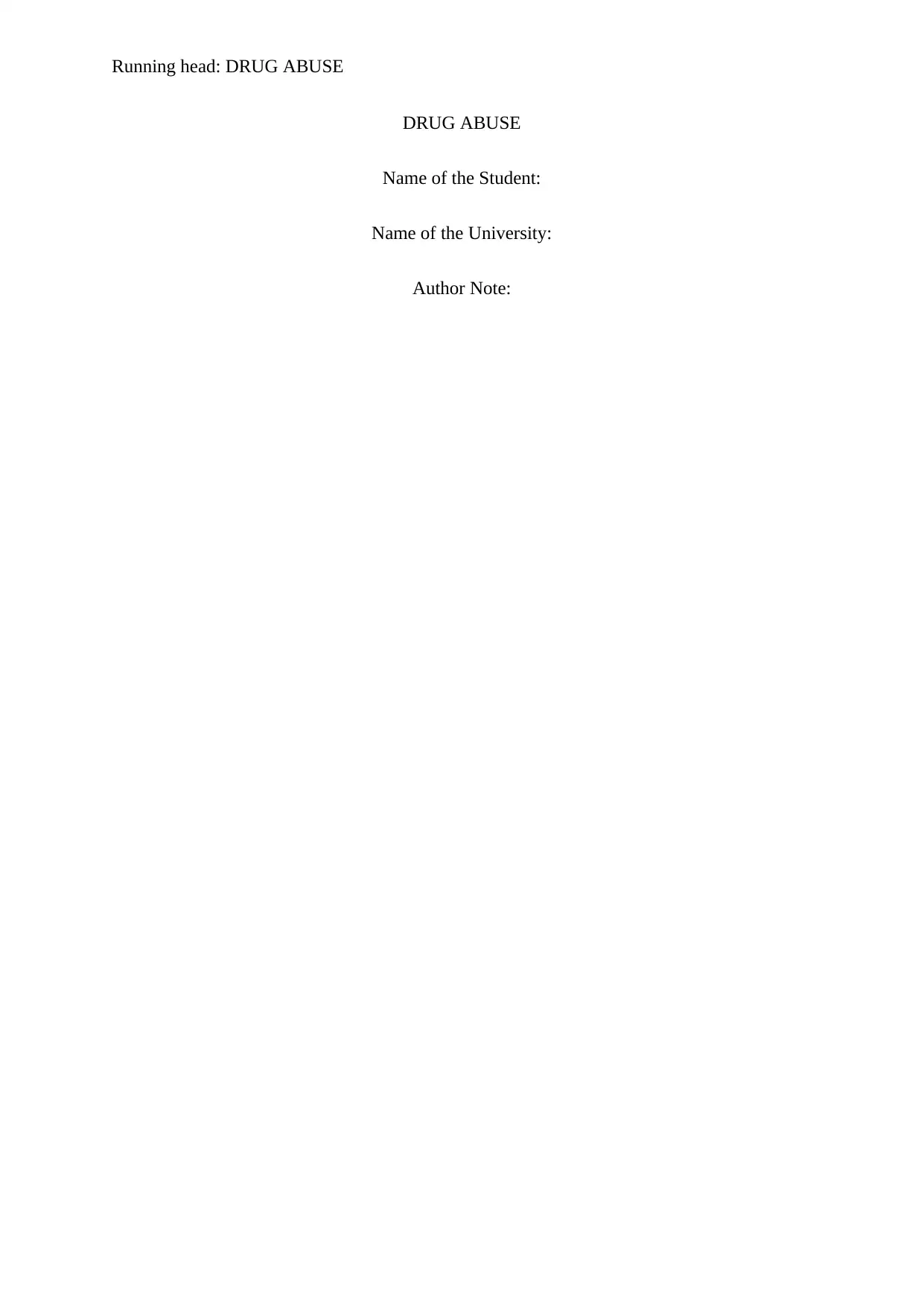
Running head: DRUG ABUSE
DRUG ABUSE
Name of the Student:
Name of the University:
Author Note:
DRUG ABUSE
Name of the Student:
Name of the University:
Author Note:
Secure Best Marks with AI Grader
Need help grading? Try our AI Grader for instant feedback on your assignments.
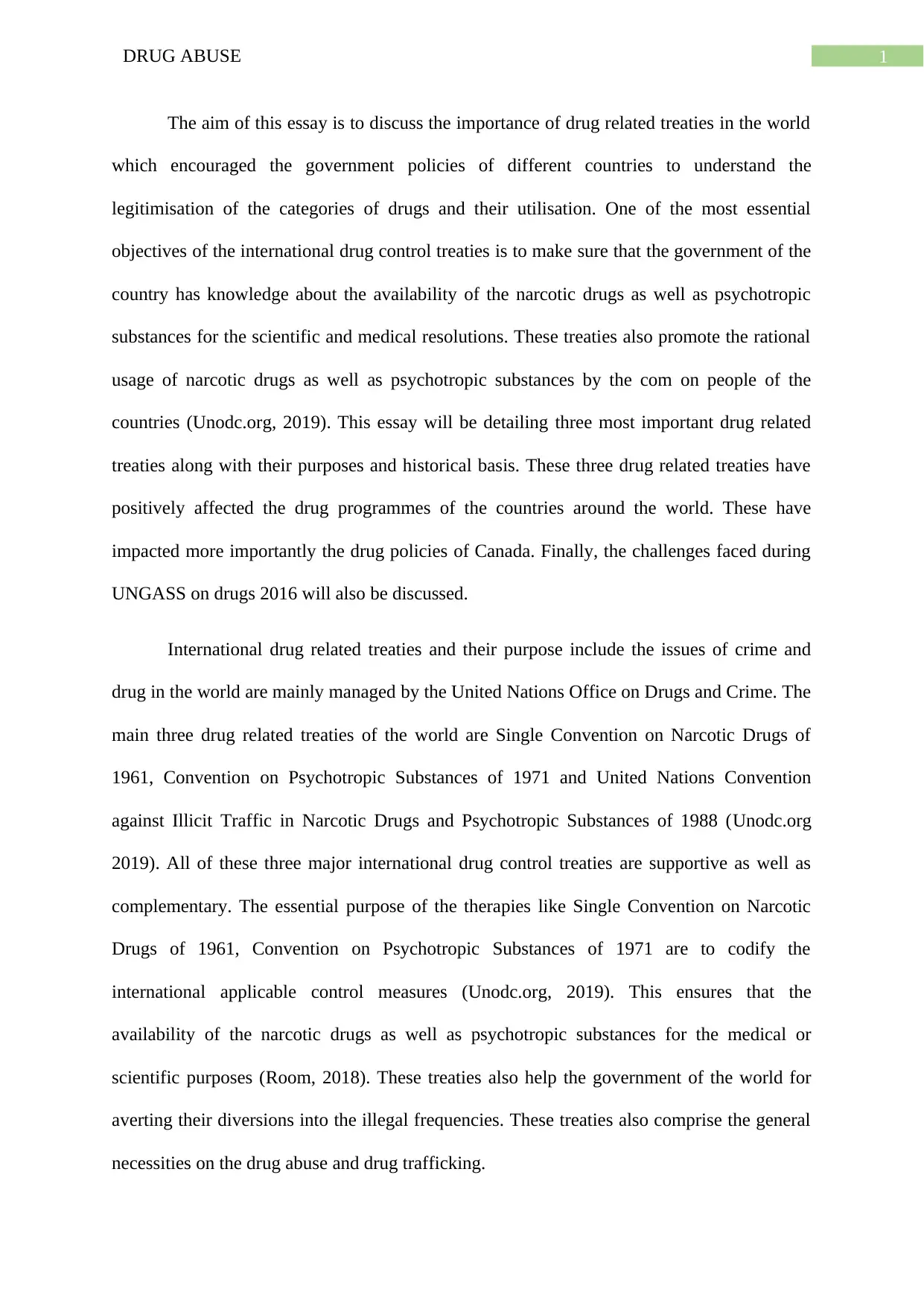
1DRUG ABUSE
The aim of this essay is to discuss the importance of drug related treaties in the world
which encouraged the government policies of different countries to understand the
legitimisation of the categories of drugs and their utilisation. One of the most essential
objectives of the international drug control treaties is to make sure that the government of the
country has knowledge about the availability of the narcotic drugs as well as psychotropic
substances for the scientific and medical resolutions. These treaties also promote the rational
usage of narcotic drugs as well as psychotropic substances by the com on people of the
countries (Unodc.org, 2019). This essay will be detailing three most important drug related
treaties along with their purposes and historical basis. These three drug related treaties have
positively affected the drug programmes of the countries around the world. These have
impacted more importantly the drug policies of Canada. Finally, the challenges faced during
UNGASS on drugs 2016 will also be discussed.
International drug related treaties and their purpose include the issues of crime and
drug in the world are mainly managed by the United Nations Office on Drugs and Crime. The
main three drug related treaties of the world are Single Convention on Narcotic Drugs of
1961, Convention on Psychotropic Substances of 1971 and United Nations Convention
against Illicit Traffic in Narcotic Drugs and Psychotropic Substances of 1988 (Unodc.org
2019). All of these three major international drug control treaties are supportive as well as
complementary. The essential purpose of the therapies like Single Convention on Narcotic
Drugs of 1961, Convention on Psychotropic Substances of 1971 are to codify the
international applicable control measures (Unodc.org, 2019). This ensures that the
availability of the narcotic drugs as well as psychotropic substances for the medical or
scientific purposes (Room, 2018). These treaties also help the government of the world for
averting their diversions into the illegal frequencies. These treaties also comprise the general
necessities on the drug abuse and drug trafficking.
The aim of this essay is to discuss the importance of drug related treaties in the world
which encouraged the government policies of different countries to understand the
legitimisation of the categories of drugs and their utilisation. One of the most essential
objectives of the international drug control treaties is to make sure that the government of the
country has knowledge about the availability of the narcotic drugs as well as psychotropic
substances for the scientific and medical resolutions. These treaties also promote the rational
usage of narcotic drugs as well as psychotropic substances by the com on people of the
countries (Unodc.org, 2019). This essay will be detailing three most important drug related
treaties along with their purposes and historical basis. These three drug related treaties have
positively affected the drug programmes of the countries around the world. These have
impacted more importantly the drug policies of Canada. Finally, the challenges faced during
UNGASS on drugs 2016 will also be discussed.
International drug related treaties and their purpose include the issues of crime and
drug in the world are mainly managed by the United Nations Office on Drugs and Crime. The
main three drug related treaties of the world are Single Convention on Narcotic Drugs of
1961, Convention on Psychotropic Substances of 1971 and United Nations Convention
against Illicit Traffic in Narcotic Drugs and Psychotropic Substances of 1988 (Unodc.org
2019). All of these three major international drug control treaties are supportive as well as
complementary. The essential purpose of the therapies like Single Convention on Narcotic
Drugs of 1961, Convention on Psychotropic Substances of 1971 are to codify the
international applicable control measures (Unodc.org, 2019). This ensures that the
availability of the narcotic drugs as well as psychotropic substances for the medical or
scientific purposes (Room, 2018). These treaties also help the government of the world for
averting their diversions into the illegal frequencies. These treaties also comprise the general
necessities on the drug abuse and drug trafficking.
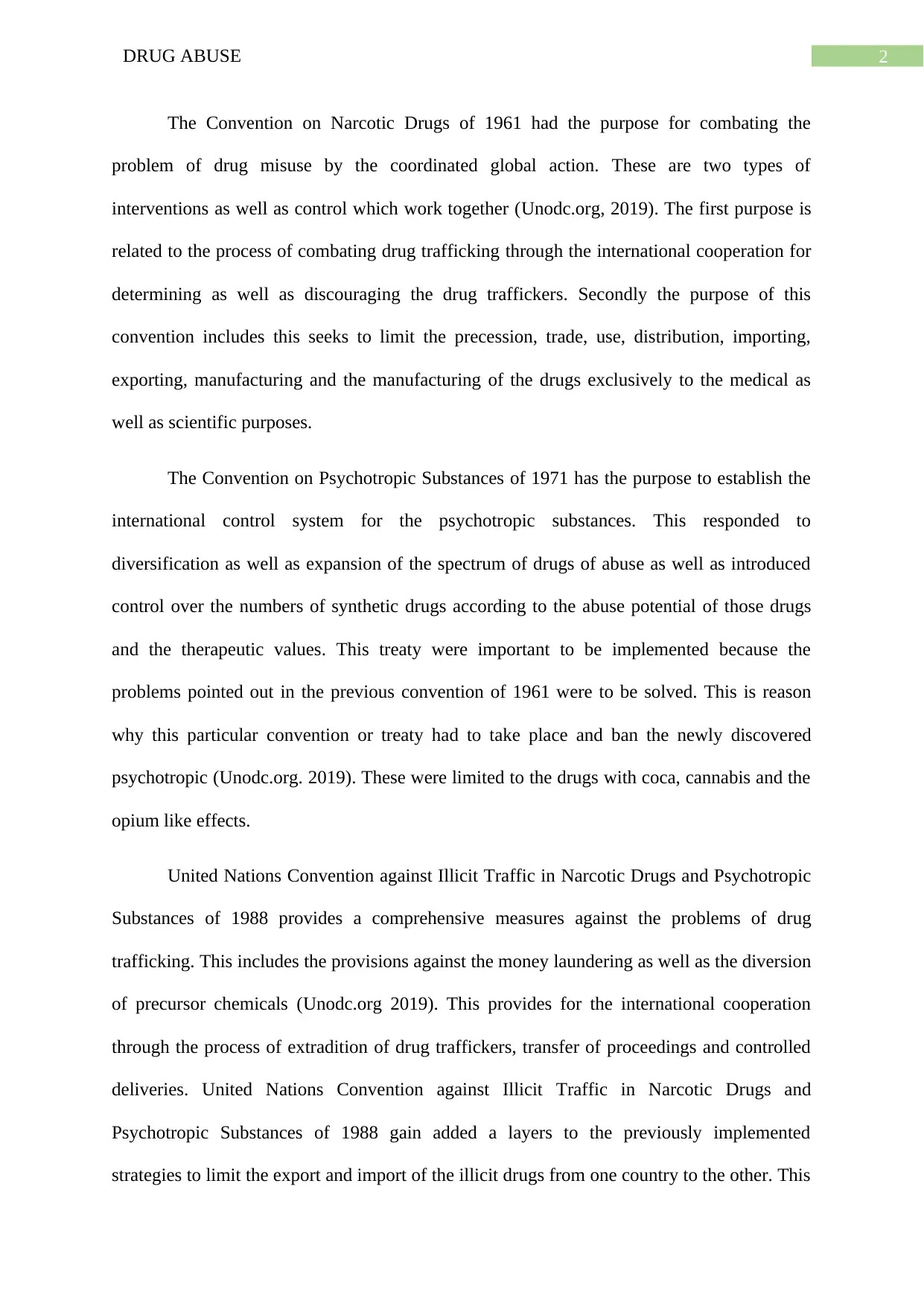
2DRUG ABUSE
The Convention on Narcotic Drugs of 1961 had the purpose for combating the
problem of drug misuse by the coordinated global action. These are two types of
interventions as well as control which work together (Unodc.org, 2019). The first purpose is
related to the process of combating drug trafficking through the international cooperation for
determining as well as discouraging the drug traffickers. Secondly the purpose of this
convention includes this seeks to limit the precession, trade, use, distribution, importing,
exporting, manufacturing and the manufacturing of the drugs exclusively to the medical as
well as scientific purposes.
The Convention on Psychotropic Substances of 1971 has the purpose to establish the
international control system for the psychotropic substances. This responded to
diversification as well as expansion of the spectrum of drugs of abuse as well as introduced
control over the numbers of synthetic drugs according to the abuse potential of those drugs
and the therapeutic values. This treaty were important to be implemented because the
problems pointed out in the previous convention of 1961 were to be solved. This is reason
why this particular convention or treaty had to take place and ban the newly discovered
psychotropic (Unodc.org. 2019). These were limited to the drugs with coca, cannabis and the
opium like effects.
United Nations Convention against Illicit Traffic in Narcotic Drugs and Psychotropic
Substances of 1988 provides a comprehensive measures against the problems of drug
trafficking. This includes the provisions against the money laundering as well as the diversion
of precursor chemicals (Unodc.org 2019). This provides for the international cooperation
through the process of extradition of drug traffickers, transfer of proceedings and controlled
deliveries. United Nations Convention against Illicit Traffic in Narcotic Drugs and
Psychotropic Substances of 1988 gain added a layers to the previously implemented
strategies to limit the export and import of the illicit drugs from one country to the other. This
The Convention on Narcotic Drugs of 1961 had the purpose for combating the
problem of drug misuse by the coordinated global action. These are two types of
interventions as well as control which work together (Unodc.org, 2019). The first purpose is
related to the process of combating drug trafficking through the international cooperation for
determining as well as discouraging the drug traffickers. Secondly the purpose of this
convention includes this seeks to limit the precession, trade, use, distribution, importing,
exporting, manufacturing and the manufacturing of the drugs exclusively to the medical as
well as scientific purposes.
The Convention on Psychotropic Substances of 1971 has the purpose to establish the
international control system for the psychotropic substances. This responded to
diversification as well as expansion of the spectrum of drugs of abuse as well as introduced
control over the numbers of synthetic drugs according to the abuse potential of those drugs
and the therapeutic values. This treaty were important to be implemented because the
problems pointed out in the previous convention of 1961 were to be solved. This is reason
why this particular convention or treaty had to take place and ban the newly discovered
psychotropic (Unodc.org. 2019). These were limited to the drugs with coca, cannabis and the
opium like effects.
United Nations Convention against Illicit Traffic in Narcotic Drugs and Psychotropic
Substances of 1988 provides a comprehensive measures against the problems of drug
trafficking. This includes the provisions against the money laundering as well as the diversion
of precursor chemicals (Unodc.org 2019). This provides for the international cooperation
through the process of extradition of drug traffickers, transfer of proceedings and controlled
deliveries. United Nations Convention against Illicit Traffic in Narcotic Drugs and
Psychotropic Substances of 1988 gain added a layers to the previously implemented
strategies to limit the export and import of the illicit drugs from one country to the other. This
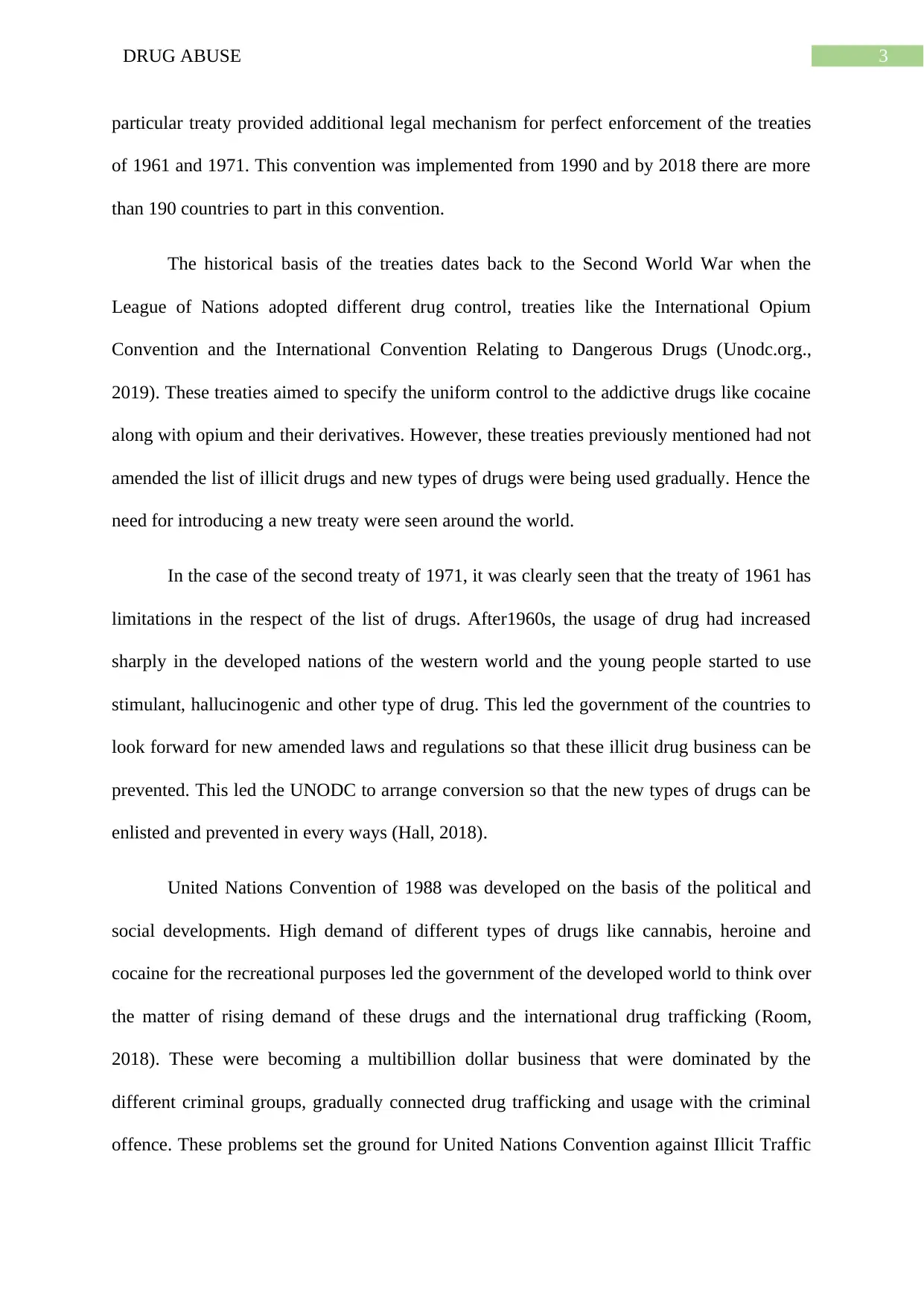
3DRUG ABUSE
particular treaty provided additional legal mechanism for perfect enforcement of the treaties
of 1961 and 1971. This convention was implemented from 1990 and by 2018 there are more
than 190 countries to part in this convention.
The historical basis of the treaties dates back to the Second World War when the
League of Nations adopted different drug control, treaties like the International Opium
Convention and the International Convention Relating to Dangerous Drugs (Unodc.org.,
2019). These treaties aimed to specify the uniform control to the addictive drugs like cocaine
along with opium and their derivatives. However, these treaties previously mentioned had not
amended the list of illicit drugs and new types of drugs were being used gradually. Hence the
need for introducing a new treaty were seen around the world.
In the case of the second treaty of 1971, it was clearly seen that the treaty of 1961 has
limitations in the respect of the list of drugs. After1960s, the usage of drug had increased
sharply in the developed nations of the western world and the young people started to use
stimulant, hallucinogenic and other type of drug. This led the government of the countries to
look forward for new amended laws and regulations so that these illicit drug business can be
prevented. This led the UNODC to arrange conversion so that the new types of drugs can be
enlisted and prevented in every ways (Hall, 2018).
United Nations Convention of 1988 was developed on the basis of the political and
social developments. High demand of different types of drugs like cannabis, heroine and
cocaine for the recreational purposes led the government of the developed world to think over
the matter of rising demand of these drugs and the international drug trafficking (Room,
2018). These were becoming a multibillion dollar business that were dominated by the
different criminal groups, gradually connected drug trafficking and usage with the criminal
offence. These problems set the ground for United Nations Convention against Illicit Traffic
particular treaty provided additional legal mechanism for perfect enforcement of the treaties
of 1961 and 1971. This convention was implemented from 1990 and by 2018 there are more
than 190 countries to part in this convention.
The historical basis of the treaties dates back to the Second World War when the
League of Nations adopted different drug control, treaties like the International Opium
Convention and the International Convention Relating to Dangerous Drugs (Unodc.org.,
2019). These treaties aimed to specify the uniform control to the addictive drugs like cocaine
along with opium and their derivatives. However, these treaties previously mentioned had not
amended the list of illicit drugs and new types of drugs were being used gradually. Hence the
need for introducing a new treaty were seen around the world.
In the case of the second treaty of 1971, it was clearly seen that the treaty of 1961 has
limitations in the respect of the list of drugs. After1960s, the usage of drug had increased
sharply in the developed nations of the western world and the young people started to use
stimulant, hallucinogenic and other type of drug. This led the government of the countries to
look forward for new amended laws and regulations so that these illicit drug business can be
prevented. This led the UNODC to arrange conversion so that the new types of drugs can be
enlisted and prevented in every ways (Hall, 2018).
United Nations Convention of 1988 was developed on the basis of the political and
social developments. High demand of different types of drugs like cannabis, heroine and
cocaine for the recreational purposes led the government of the developed world to think over
the matter of rising demand of these drugs and the international drug trafficking (Room,
2018). These were becoming a multibillion dollar business that were dominated by the
different criminal groups, gradually connected drug trafficking and usage with the criminal
offence. These problems set the ground for United Nations Convention against Illicit Traffic
Secure Best Marks with AI Grader
Need help grading? Try our AI Grader for instant feedback on your assignments.
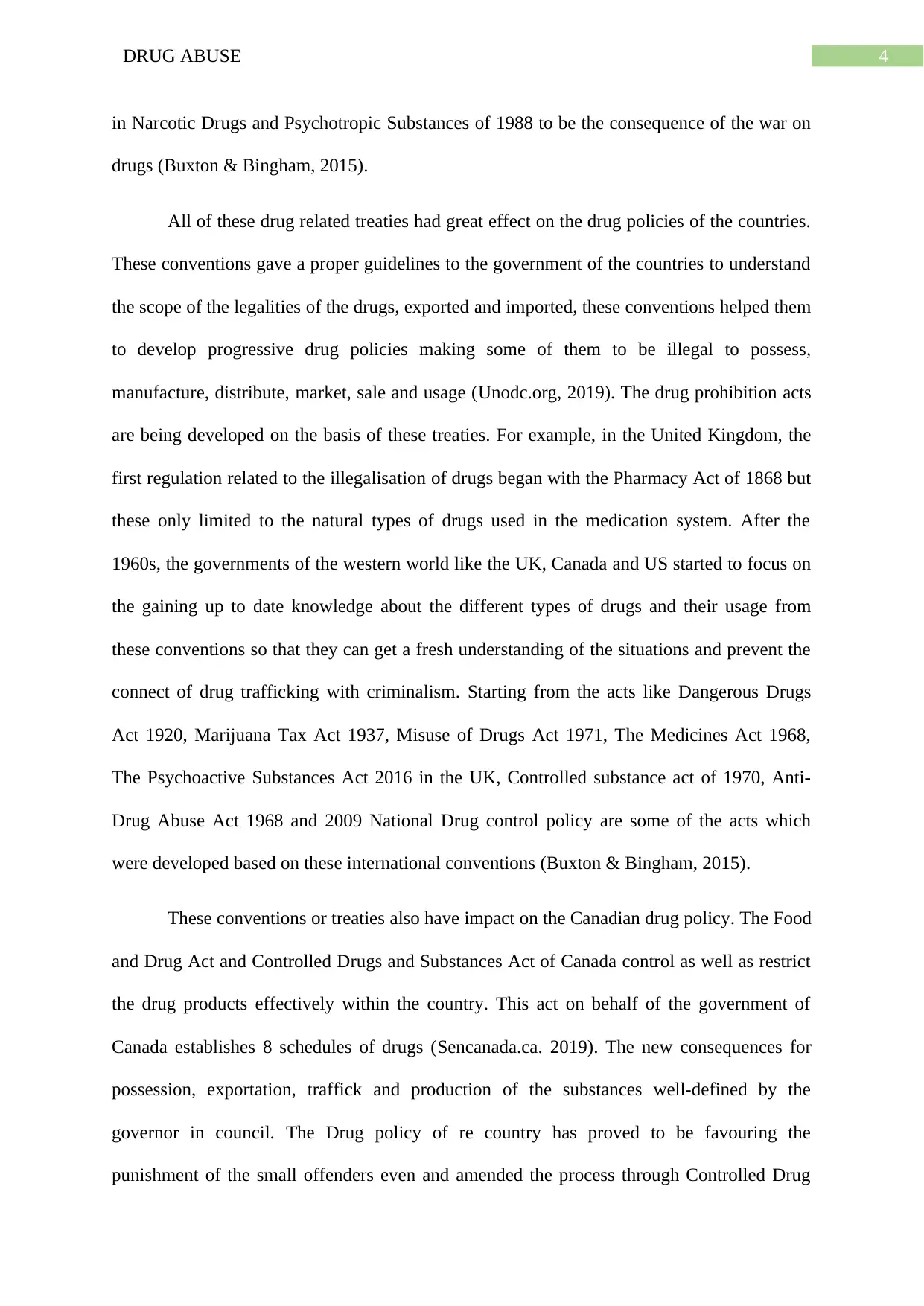
4DRUG ABUSE
in Narcotic Drugs and Psychotropic Substances of 1988 to be the consequence of the war on
drugs (Buxton & Bingham, 2015).
All of these drug related treaties had great effect on the drug policies of the countries.
These conventions gave a proper guidelines to the government of the countries to understand
the scope of the legalities of the drugs, exported and imported, these conventions helped them
to develop progressive drug policies making some of them to be illegal to possess,
manufacture, distribute, market, sale and usage (Unodc.org, 2019). The drug prohibition acts
are being developed on the basis of these treaties. For example, in the United Kingdom, the
first regulation related to the illegalisation of drugs began with the Pharmacy Act of 1868 but
these only limited to the natural types of drugs used in the medication system. After the
1960s, the governments of the western world like the UK, Canada and US started to focus on
the gaining up to date knowledge about the different types of drugs and their usage from
these conventions so that they can get a fresh understanding of the situations and prevent the
connect of drug trafficking with criminalism. Starting from the acts like Dangerous Drugs
Act 1920, Marijuana Tax Act 1937, Misuse of Drugs Act 1971, The Medicines Act 1968,
The Psychoactive Substances Act 2016 in the UK, Controlled substance act of 1970, Anti-
Drug Abuse Act 1968 and 2009 National Drug control policy are some of the acts which
were developed based on these international conventions (Buxton & Bingham, 2015).
These conventions or treaties also have impact on the Canadian drug policy. The Food
and Drug Act and Controlled Drugs and Substances Act of Canada control as well as restrict
the drug products effectively within the country. This act on behalf of the government of
Canada establishes 8 schedules of drugs (Sencanada.ca. 2019). The new consequences for
possession, exportation, traffick and production of the substances well-defined by the
governor in council. The Drug policy of re country has proved to be favouring the
punishment of the small offenders even and amended the process through Controlled Drug
in Narcotic Drugs and Psychotropic Substances of 1988 to be the consequence of the war on
drugs (Buxton & Bingham, 2015).
All of these drug related treaties had great effect on the drug policies of the countries.
These conventions gave a proper guidelines to the government of the countries to understand
the scope of the legalities of the drugs, exported and imported, these conventions helped them
to develop progressive drug policies making some of them to be illegal to possess,
manufacture, distribute, market, sale and usage (Unodc.org, 2019). The drug prohibition acts
are being developed on the basis of these treaties. For example, in the United Kingdom, the
first regulation related to the illegalisation of drugs began with the Pharmacy Act of 1868 but
these only limited to the natural types of drugs used in the medication system. After the
1960s, the governments of the western world like the UK, Canada and US started to focus on
the gaining up to date knowledge about the different types of drugs and their usage from
these conventions so that they can get a fresh understanding of the situations and prevent the
connect of drug trafficking with criminalism. Starting from the acts like Dangerous Drugs
Act 1920, Marijuana Tax Act 1937, Misuse of Drugs Act 1971, The Medicines Act 1968,
The Psychoactive Substances Act 2016 in the UK, Controlled substance act of 1970, Anti-
Drug Abuse Act 1968 and 2009 National Drug control policy are some of the acts which
were developed based on these international conventions (Buxton & Bingham, 2015).
These conventions or treaties also have impact on the Canadian drug policy. The Food
and Drug Act and Controlled Drugs and Substances Act of Canada control as well as restrict
the drug products effectively within the country. This act on behalf of the government of
Canada establishes 8 schedules of drugs (Sencanada.ca. 2019). The new consequences for
possession, exportation, traffick and production of the substances well-defined by the
governor in council. The Drug policy of re country has proved to be favouring the
punishment of the small offenders even and amended the process through Controlled Drug
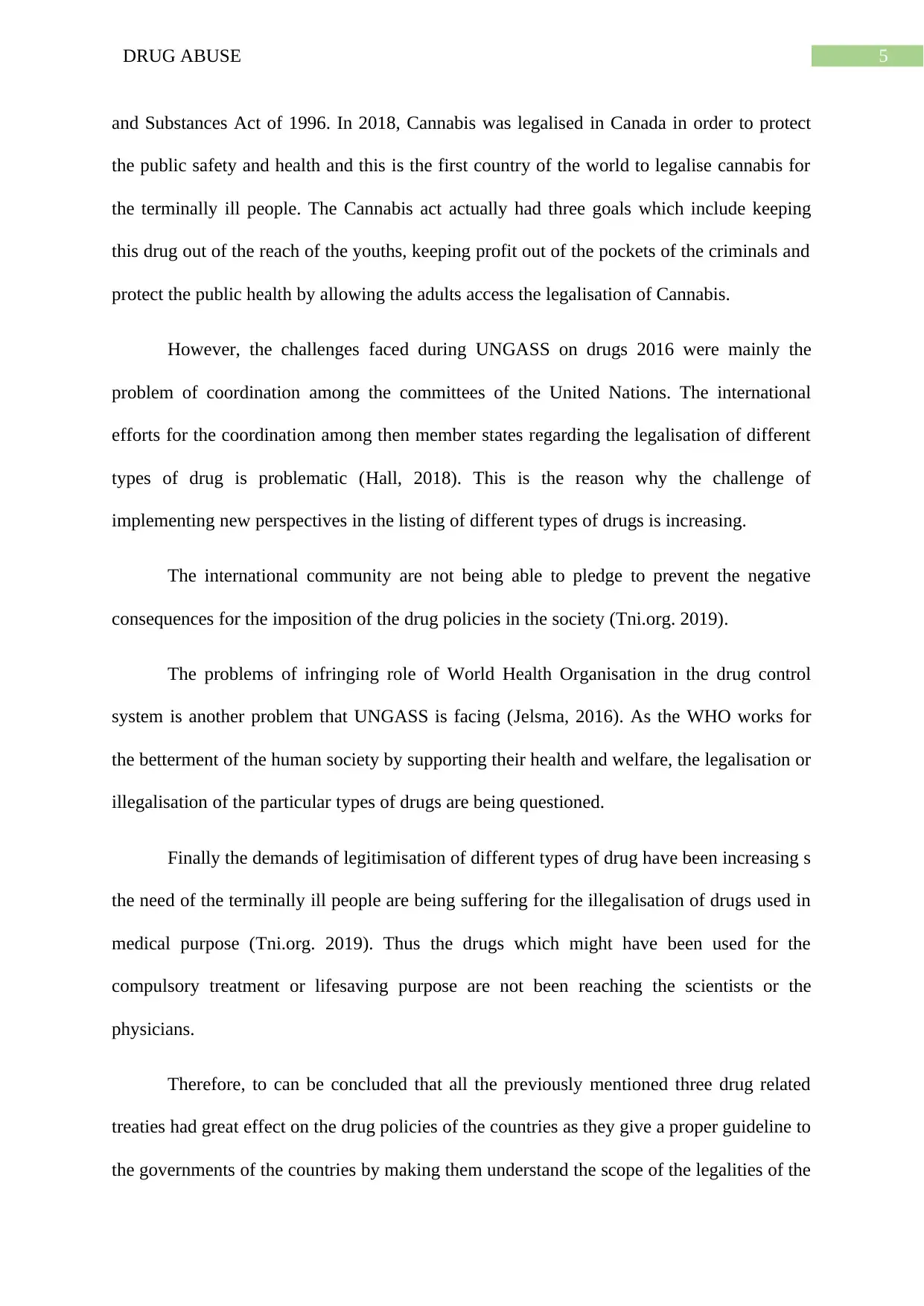
5DRUG ABUSE
and Substances Act of 1996. In 2018, Cannabis was legalised in Canada in order to protect
the public safety and health and this is the first country of the world to legalise cannabis for
the terminally ill people. The Cannabis act actually had three goals which include keeping
this drug out of the reach of the youths, keeping profit out of the pockets of the criminals and
protect the public health by allowing the adults access the legalisation of Cannabis.
However, the challenges faced during UNGASS on drugs 2016 were mainly the
problem of coordination among the committees of the United Nations. The international
efforts for the coordination among then member states regarding the legalisation of different
types of drug is problematic (Hall, 2018). This is the reason why the challenge of
implementing new perspectives in the listing of different types of drugs is increasing.
The international community are not being able to pledge to prevent the negative
consequences for the imposition of the drug policies in the society (Tni.org. 2019).
The problems of infringing role of World Health Organisation in the drug control
system is another problem that UNGASS is facing (Jelsma, 2016). As the WHO works for
the betterment of the human society by supporting their health and welfare, the legalisation or
illegalisation of the particular types of drugs are being questioned.
Finally the demands of legitimisation of different types of drug have been increasing s
the need of the terminally ill people are being suffering for the illegalisation of drugs used in
medical purpose (Tni.org. 2019). Thus the drugs which might have been used for the
compulsory treatment or lifesaving purpose are not been reaching the scientists or the
physicians.
Therefore, to can be concluded that all the previously mentioned three drug related
treaties had great effect on the drug policies of the countries as they give a proper guideline to
the governments of the countries by making them understand the scope of the legalities of the
and Substances Act of 1996. In 2018, Cannabis was legalised in Canada in order to protect
the public safety and health and this is the first country of the world to legalise cannabis for
the terminally ill people. The Cannabis act actually had three goals which include keeping
this drug out of the reach of the youths, keeping profit out of the pockets of the criminals and
protect the public health by allowing the adults access the legalisation of Cannabis.
However, the challenges faced during UNGASS on drugs 2016 were mainly the
problem of coordination among the committees of the United Nations. The international
efforts for the coordination among then member states regarding the legalisation of different
types of drug is problematic (Hall, 2018). This is the reason why the challenge of
implementing new perspectives in the listing of different types of drugs is increasing.
The international community are not being able to pledge to prevent the negative
consequences for the imposition of the drug policies in the society (Tni.org. 2019).
The problems of infringing role of World Health Organisation in the drug control
system is another problem that UNGASS is facing (Jelsma, 2016). As the WHO works for
the betterment of the human society by supporting their health and welfare, the legalisation or
illegalisation of the particular types of drugs are being questioned.
Finally the demands of legitimisation of different types of drug have been increasing s
the need of the terminally ill people are being suffering for the illegalisation of drugs used in
medical purpose (Tni.org. 2019). Thus the drugs which might have been used for the
compulsory treatment or lifesaving purpose are not been reaching the scientists or the
physicians.
Therefore, to can be concluded that all the previously mentioned three drug related
treaties had great effect on the drug policies of the countries as they give a proper guideline to
the governments of the countries by making them understand the scope of the legalities of the
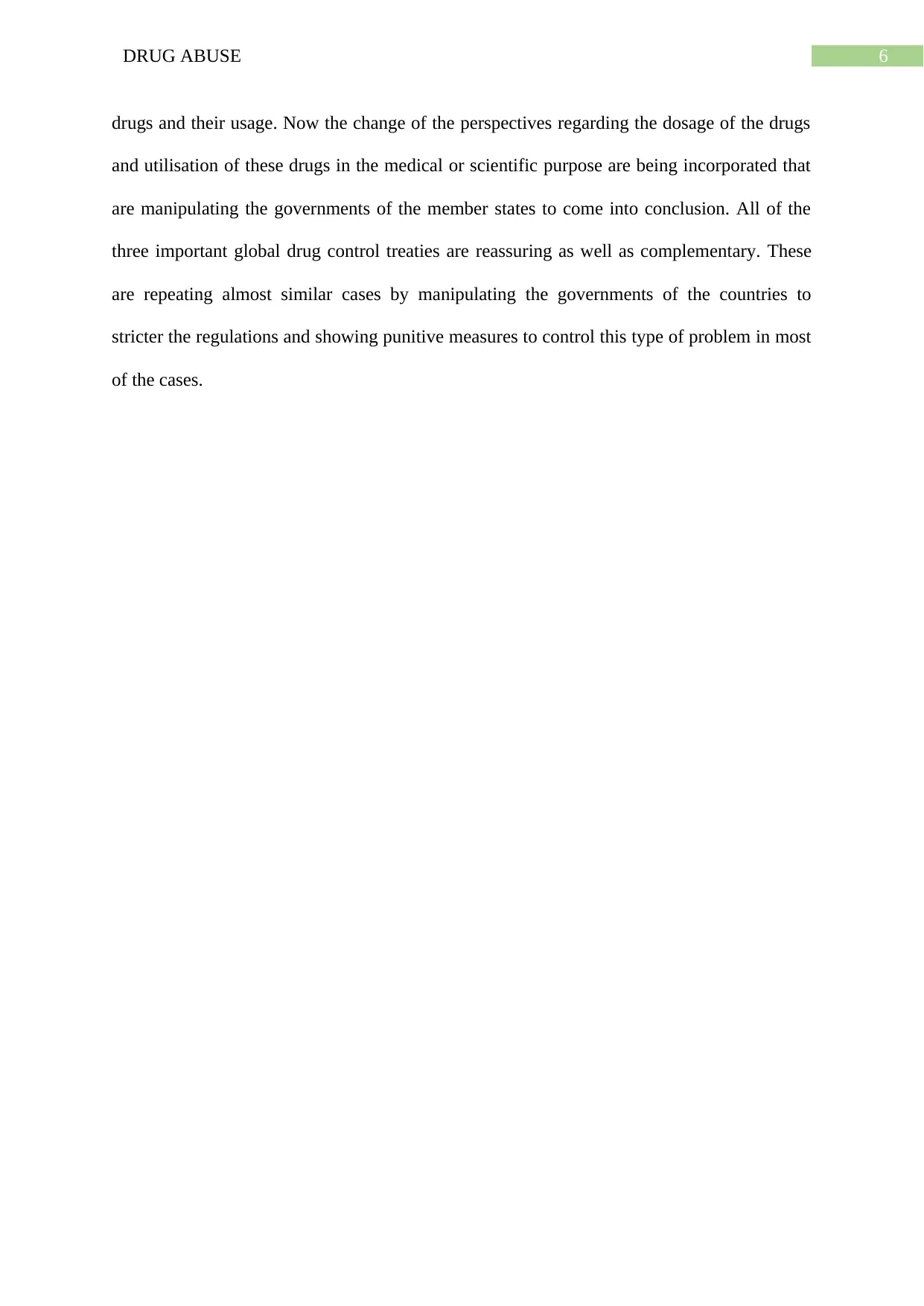
6DRUG ABUSE
drugs and their usage. Now the change of the perspectives regarding the dosage of the drugs
and utilisation of these drugs in the medical or scientific purpose are being incorporated that
are manipulating the governments of the member states to come into conclusion. All of the
three important global drug control treaties are reassuring as well as complementary. These
are repeating almost similar cases by manipulating the governments of the countries to
stricter the regulations and showing punitive measures to control this type of problem in most
of the cases.
drugs and their usage. Now the change of the perspectives regarding the dosage of the drugs
and utilisation of these drugs in the medical or scientific purpose are being incorporated that
are manipulating the governments of the member states to come into conclusion. All of the
three important global drug control treaties are reassuring as well as complementary. These
are repeating almost similar cases by manipulating the governments of the countries to
stricter the regulations and showing punitive measures to control this type of problem in most
of the cases.
Paraphrase This Document
Need a fresh take? Get an instant paraphrase of this document with our AI Paraphraser
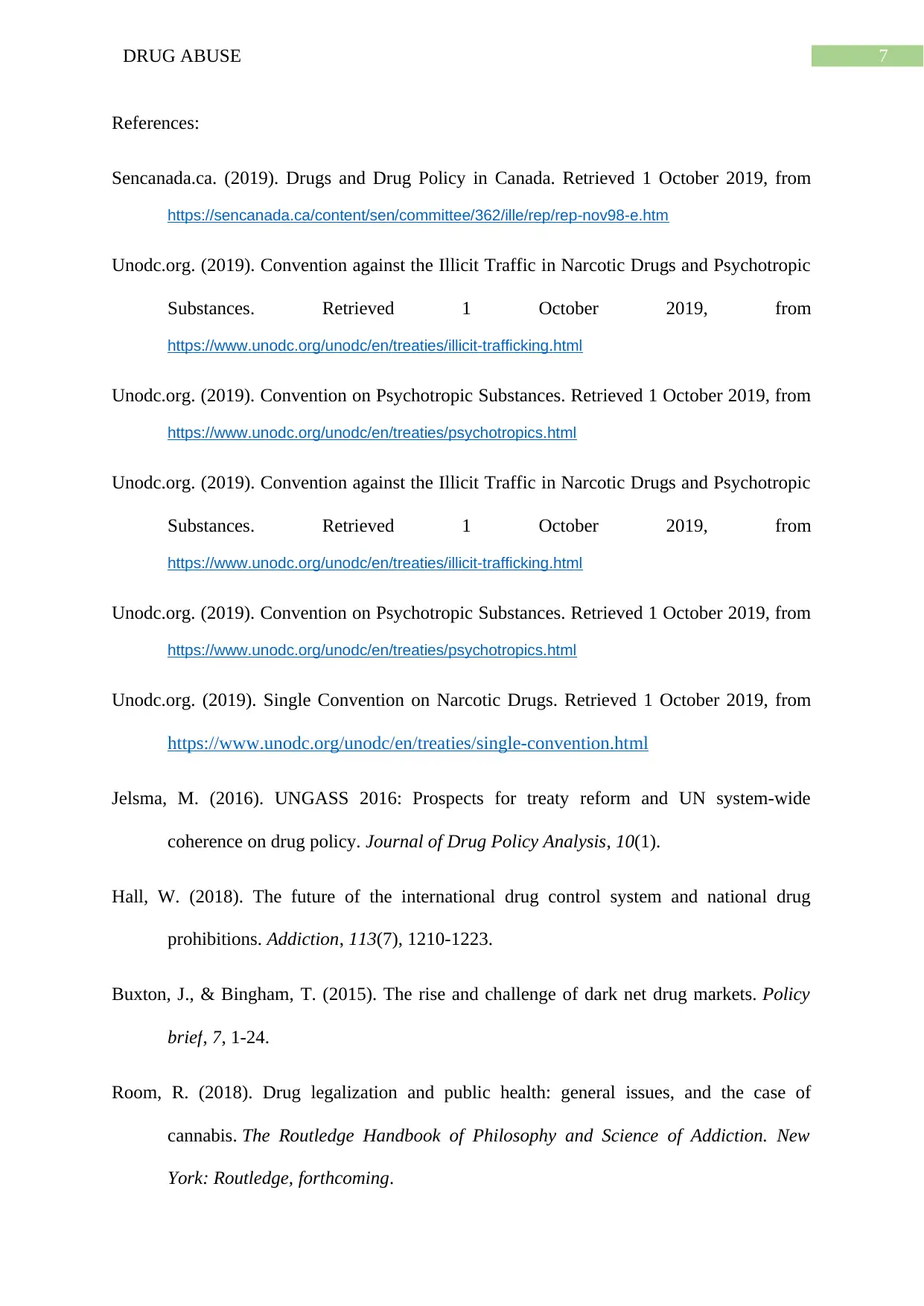
7DRUG ABUSE
References:
Sencanada.ca. (2019). Drugs and Drug Policy in Canada. Retrieved 1 October 2019, from
https://sencanada.ca/content/sen/committee/362/ille/rep/rep-nov98-e.htm
Unodc.org. (2019). Convention against the Illicit Traffic in Narcotic Drugs and Psychotropic
Substances. Retrieved 1 October 2019, from
https://www.unodc.org/unodc/en/treaties/illicit-trafficking.html
Unodc.org. (2019). Convention on Psychotropic Substances. Retrieved 1 October 2019, from
https://www.unodc.org/unodc/en/treaties/psychotropics.html
Unodc.org. (2019). Convention against the Illicit Traffic in Narcotic Drugs and Psychotropic
Substances. Retrieved 1 October 2019, from
https://www.unodc.org/unodc/en/treaties/illicit-trafficking.html
Unodc.org. (2019). Convention on Psychotropic Substances. Retrieved 1 October 2019, from
https://www.unodc.org/unodc/en/treaties/psychotropics.html
Unodc.org. (2019). Single Convention on Narcotic Drugs. Retrieved 1 October 2019, from
https://www.unodc.org/unodc/en/treaties/single-convention.html
Jelsma, M. (2016). UNGASS 2016: Prospects for treaty reform and UN system-wide
coherence on drug policy. Journal of Drug Policy Analysis, 10(1).
Hall, W. (2018). The future of the international drug control system and national drug
prohibitions. Addiction, 113(7), 1210-1223.
Buxton, J., & Bingham, T. (2015). The rise and challenge of dark net drug markets. Policy
brief, 7, 1-24.
Room, R. (2018). Drug legalization and public health: general issues, and the case of
cannabis. The Routledge Handbook of Philosophy and Science of Addiction. New
York: Routledge, forthcoming.
References:
Sencanada.ca. (2019). Drugs and Drug Policy in Canada. Retrieved 1 October 2019, from
https://sencanada.ca/content/sen/committee/362/ille/rep/rep-nov98-e.htm
Unodc.org. (2019). Convention against the Illicit Traffic in Narcotic Drugs and Psychotropic
Substances. Retrieved 1 October 2019, from
https://www.unodc.org/unodc/en/treaties/illicit-trafficking.html
Unodc.org. (2019). Convention on Psychotropic Substances. Retrieved 1 October 2019, from
https://www.unodc.org/unodc/en/treaties/psychotropics.html
Unodc.org. (2019). Convention against the Illicit Traffic in Narcotic Drugs and Psychotropic
Substances. Retrieved 1 October 2019, from
https://www.unodc.org/unodc/en/treaties/illicit-trafficking.html
Unodc.org. (2019). Convention on Psychotropic Substances. Retrieved 1 October 2019, from
https://www.unodc.org/unodc/en/treaties/psychotropics.html
Unodc.org. (2019). Single Convention on Narcotic Drugs. Retrieved 1 October 2019, from
https://www.unodc.org/unodc/en/treaties/single-convention.html
Jelsma, M. (2016). UNGASS 2016: Prospects for treaty reform and UN system-wide
coherence on drug policy. Journal of Drug Policy Analysis, 10(1).
Hall, W. (2018). The future of the international drug control system and national drug
prohibitions. Addiction, 113(7), 1210-1223.
Buxton, J., & Bingham, T. (2015). The rise and challenge of dark net drug markets. Policy
brief, 7, 1-24.
Room, R. (2018). Drug legalization and public health: general issues, and the case of
cannabis. The Routledge Handbook of Philosophy and Science of Addiction. New
York: Routledge, forthcoming.

8DRUG ABUSE
Tni.org. (2019). Retrieved 1 October 2019, from https://www.tni.org/en/article/the-2016-ungass-
challenges-and-opportunities
Tni.org. (2019). Retrieved 1 October 2019, from https://www.tni.org/en/publication/the-un-drug-
control-conventions
Tni.org. (2019). Retrieved 1 October 2019, from https://www.tni.org/en/article/the-2016-ungass-
challenges-and-opportunities
Tni.org. (2019). Retrieved 1 October 2019, from https://www.tni.org/en/publication/the-un-drug-
control-conventions
1 out of 9
Related Documents
Your All-in-One AI-Powered Toolkit for Academic Success.
+13062052269
info@desklib.com
Available 24*7 on WhatsApp / Email
![[object Object]](/_next/static/media/star-bottom.7253800d.svg)
Unlock your academic potential
© 2024 | Zucol Services PVT LTD | All rights reserved.




